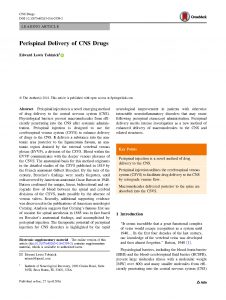 May 2, 2016 (Los Angeles, Boca Raton): On April 27, 2016, the peer-reviewed review article entitled, Perispinal Delivery of CNS Drugs, by Edward Tobinick MD, published online in the scientific journal CNS Drugs. The abstract of the article states:
May 2, 2016 (Los Angeles, Boca Raton): On April 27, 2016, the peer-reviewed review article entitled, Perispinal Delivery of CNS Drugs, by Edward Tobinick MD, published online in the scientific journal CNS Drugs. The abstract of the article states:
Perispinal injection is a novel emerging method of drug delivery to the central nervous system (CNS). Physiological barriers prevent macromolecules from efficiently penetrating into the CNS after systemic administration. Perispinal injection is designed to use the cerebrospinal venous system (CSVS) to enhance delivery of drugs to the CNS. It delivers a substance into the anatomic area posterior to the ligamentum flavum, an anatomic region drained by the external vertebral venous plexus (EVVP), a division of the CSVS. Blood within the EVVP communicates with the deeper venous plexuses of the CSVS. The anatomical basis for this method originates in the detailed studies of the CSVS published in 1819 by the French anatomist Gilbert Breschet. By the turn of the century, Breschet’s findings were nearly forgotten, until rediscovered by American anatomist Oscar Batson in 1940. Batson confirmed the unique, linear, bidirectional and retrograde flow of blood between the spinal and cerebral divisions of the CSVS, made possible by the absence of venous valves. Recently, additional supporting evidence was discovered in the publications of American neurologist Corning. Analysis suggests that Corning’s famous first use of cocaine for spinal anesthesia in 1885 was in fact based on Breschet’s anatomical findings, and accomplished by perispinal injection. The therapeutic potential of perispinal injection for CNS disorders is highlighted by the rapid neurological improvement in patients with otherwise intractable neuroinflammatory disorders that may ensue following perispinal etanercept administration. Perispinal delivery merits intense investigation as a new method of enhanced delivery of macromolecules to the CNS and related structures.
The full-text of the article is available by clicking on the link below:
Perispinal Delivery of CNS Drugs. Edward Tobinick MD. CNS Drugs. 2016:1-12. do:10.1007/s40263-016-0339-2, published online 27 April 2016. (Download free full-text PDF).
Comments: 0
On March 29, 2015 the television news program “Sunday Night” in Australia aired a national news feature story about INR’s perispinal etanercept stroke treatment. The story was entitled “The New Stroke Treatment That’s Changing Lives”, and it is accessible online at the link:
https://au.news.yahoo.com/sunday-night/features/a/26856981/the-new-stroke-treatment-thats-changing-lives/
Sunday Night “The New Stroke Treatment That’s Changing Lives”.
In the television feature, the clinical results of two patients treated at the INR by INR Los Angeles medical director Nancy Kim M.D., are depicted. The story was filmed both in Los Angeles at the time of treatment and in Australia, after each of the patients returned home.
Disclaimer: Individual results vary, not all patients respond. Continuing maintenance treatment may be necessary to maintain the clinical response. Treatment for this indication is off-label. Please see the Terms of Use. The method of treatment utilized is a patented invention of the INR. Issued and pending U.S. and foreign patents, including, but not limited to, U.S. 6419944, 6537549, 6982089, 7214658, 7629311, 8119127, 8236306, 8349323 and 8900583 all assigned to TACT IP, LLC; and Australian patent 758523.
Comments: 0
July 2015: Two Australian scientists, including an Emeritus Professor at the Australian National University and a neuroscientist from the Garvan Institute, have published a new review article for neurologists on TNF. The article discusses the science of TNF, its physiology and the scientific rationale for perispinal etanercept for treatment of post-stroke neurological dysfunction and other brain disorders.
The article is open access, so the INR PLLC has made it freely downloadable by double-clicking on the links provided, so that readers may read this at home, or send the article to their neurologist, physicians, or family members.
Clark, I.A. and Bryce Vissel, A Neurologist’s Guide to TNF Biology and to the Principles behind the Therapeutic Removal of Excess TNF in Disease. Neural Plasticity, 2015, Article ID 358263.http://dx.doi.org/10.1155/2015/358263 . FREE FULL-TEXT.
Comments: 0
Rapid neurological recovery beginning within minutes, 1.5 years after stroke in a patient from New Zealand. The patient’s wife describes improvement in walking ability, language abilities, sensation, vision, hearing, taste, etc. Video made at the Institute of Neurological Recovery in Los Angeles on June 9, 2014. Treatment with a single dose was on June 2, 2014.
6 July 2014
Dave and Brenda’s story published in the Otago Daily Times: “Rising to the challenge of a stroke” by Eileen Goodwin on Sunday, July 6, 2014.
“A Dunedin man thought to be the first New Zealander to undergo innovative stroke treatment in the United States believes it has improved his speech and walking, while reducing fatigue and pain….”
To read the entire story, please click here.
To view the video, please click here.
Disclaimer: Individual results vary, not all patients respond. Continuing maintenance treatment may be necessary to maintain the clinical response. The method utilized for this indication is off-label. Please see the Terms of Use. Copyright 2018 INR PLLC, all rights reserved. Issued and pending U.S. and foreign patents, including, but not limited to, U.S. 6419944, 6537549, 6982089, 7214658, 7629311, 8119127, 8236306 and 8349323, all assigned to TACT IP, LLC; and Australian patent 758523.
Comments: 0